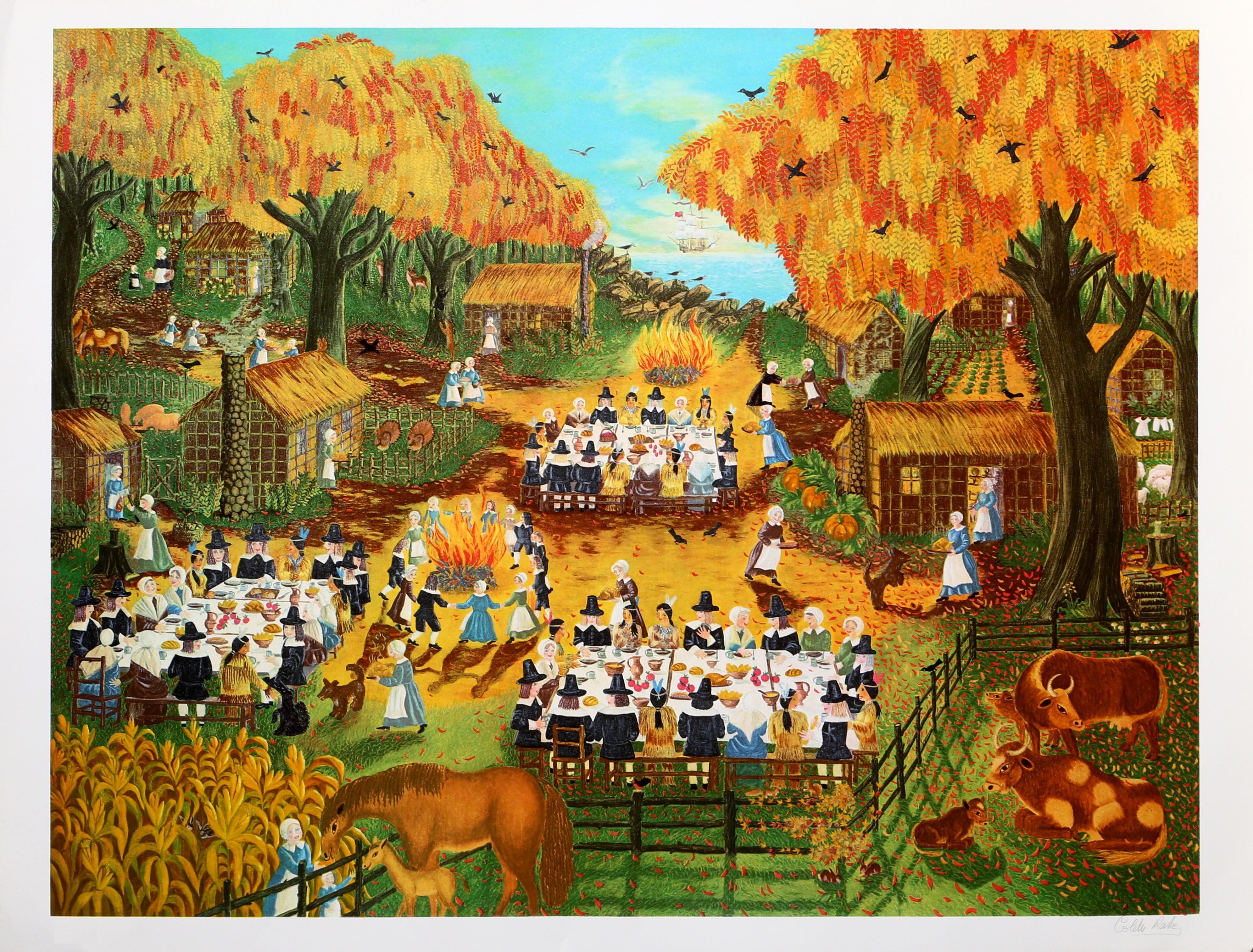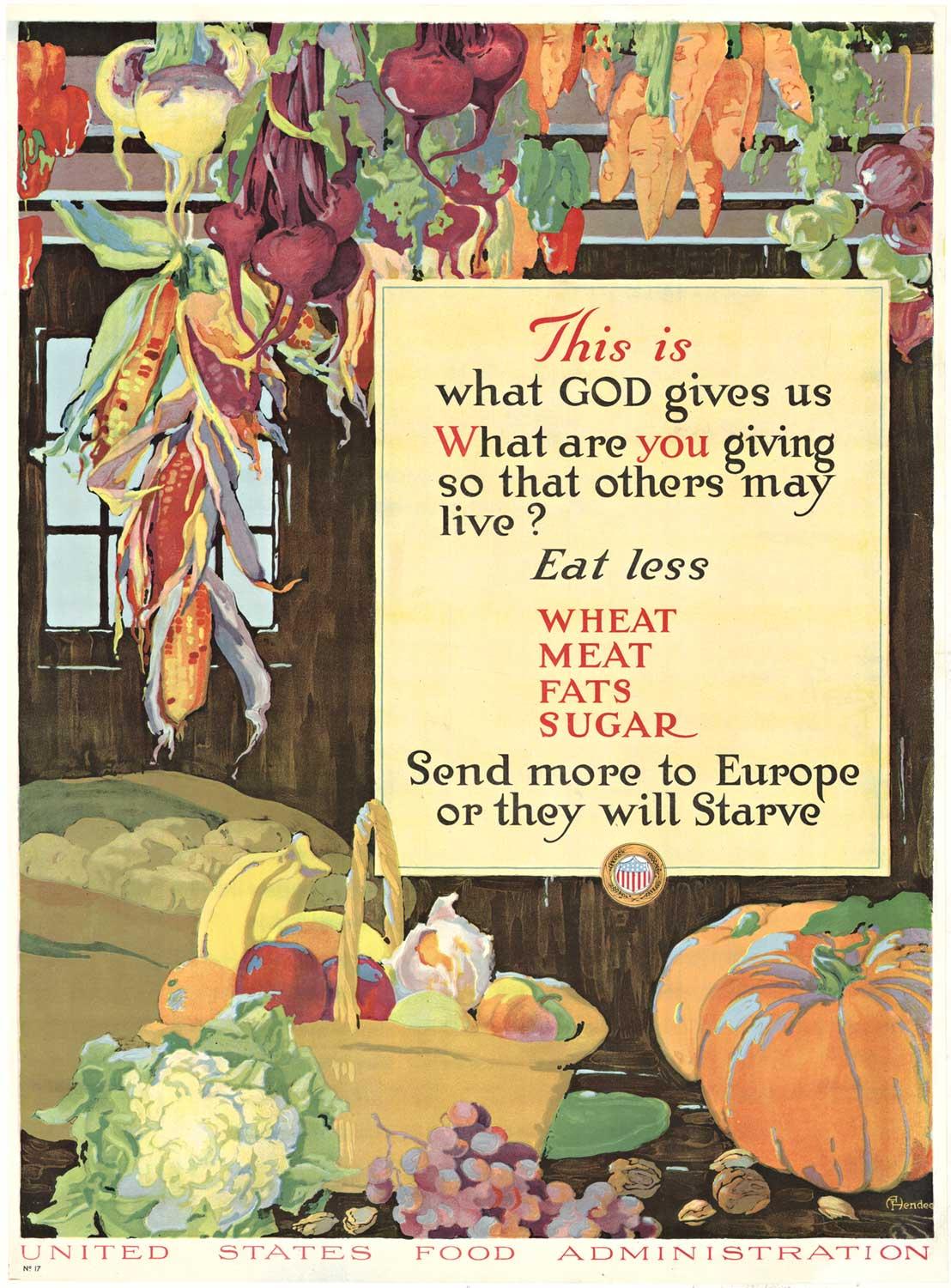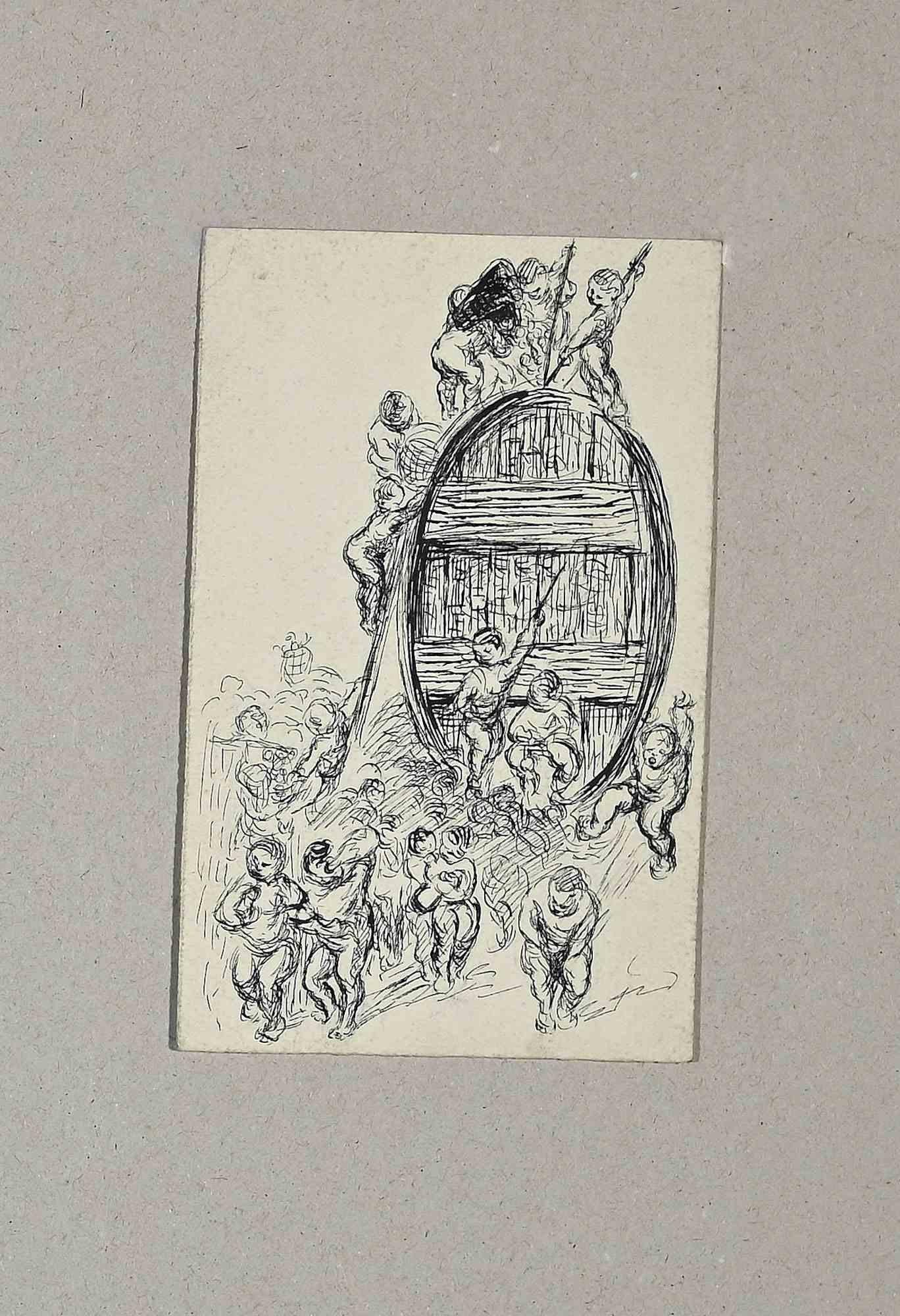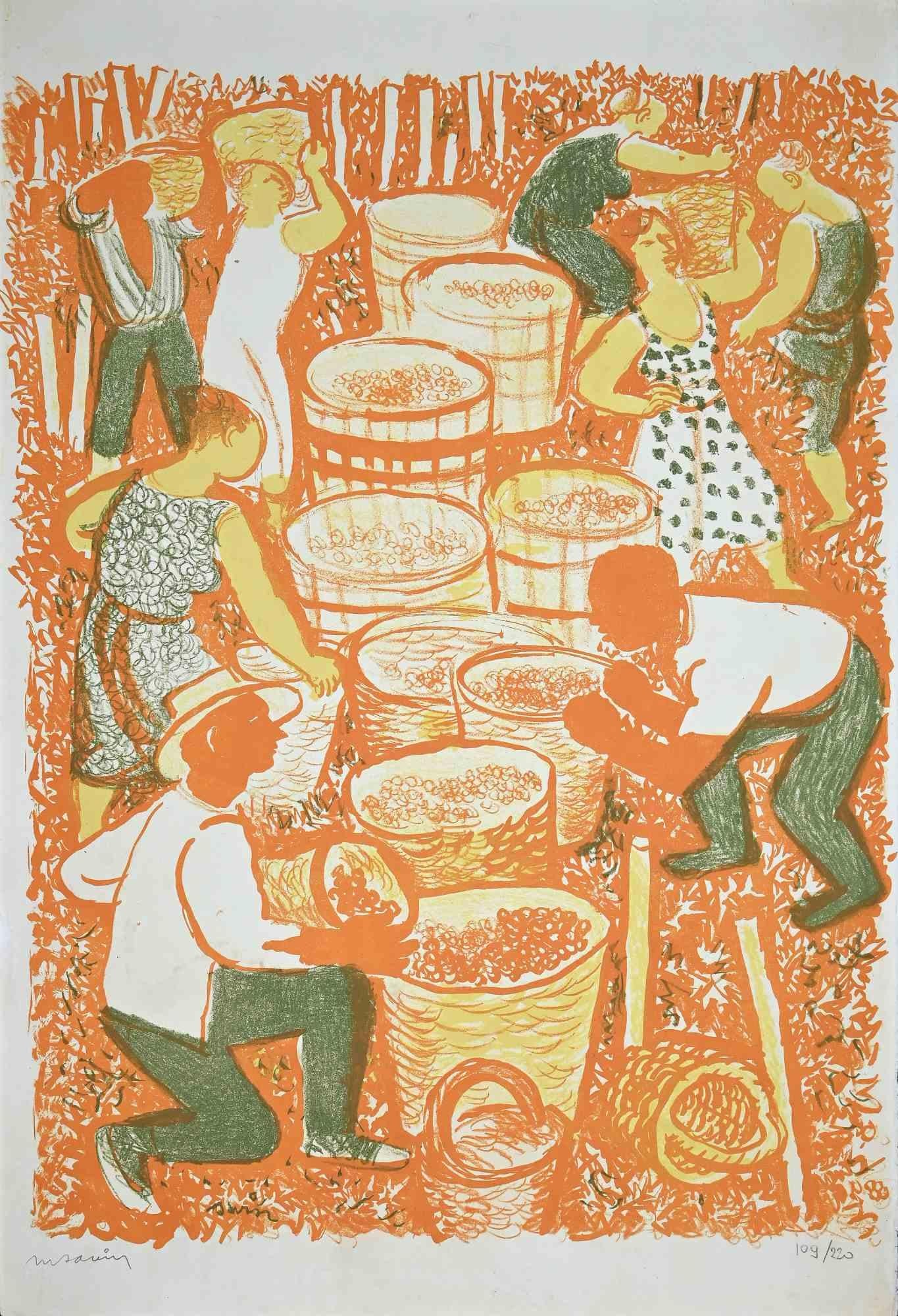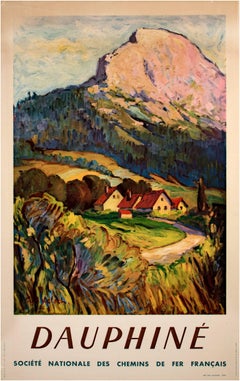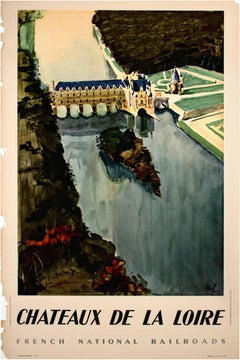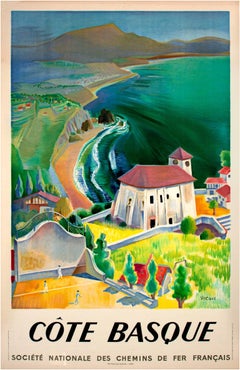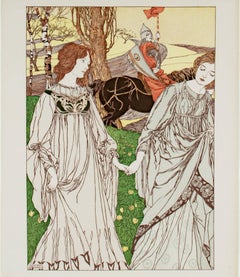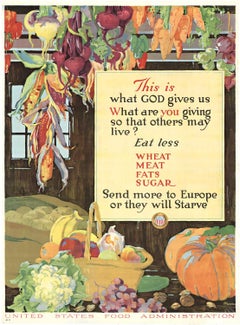Items Similar to "Harvest Home - Henry Alford Poem, " Color Lithograph Poster of Pumpkins & Hay
Want more images or videos?
Request additional images or videos from the seller
1 of 9
Unknown"Harvest Home - Henry Alford Poem, " Color Lithograph Poster of Pumpkins & Haycirca 1921
circa 1921
$1,250
£949.41
€1,091.99
CA$1,746.50
A$1,947.54
CHF 1,016.14
MX$23,897.04
NOK 12,933.88
SEK 12,254.57
DKK 8,149.93
Shipping
Retrieving quote...The 1stDibs Promise:
Authenticity Guarantee,
Money-Back Guarantee,
24-Hour Cancellation
About the Item
"Harvest Home" is an original color lithograph poster by an unknown artist. It features a scene of a field with a few pumpkins and wheat. Below the image is an excerpt from a Henry Alford poem:
"Come ye thankful people, come,
Raise the song of Harvest-home,
All is safely gathered in
Ere the winter storms begin."
- Creation Year:circa 1921
- Dimensions:Height: 29.75 in (75.57 cm)Width: 24.25 in (61.6 cm)
- Medium:
- Period:
- Condition:
- Gallery Location:Milwaukee, WI
- Reference Number:Seller: 5155d1stDibs: LU60532913021
About the Seller
4.9
Platinum Seller
Premium sellers with a 4.7+ rating and 24-hour response times
Established in 1966
1stDibs seller since 2017
435 sales on 1stDibs
Typical response time: 2 hours
- ShippingRetrieving quote...Shipping from: Milwaukee, WI
- Return Policy
Authenticity Guarantee
In the unlikely event there’s an issue with an item’s authenticity, contact us within 1 year for a full refund. DetailsMoney-Back Guarantee
If your item is not as described, is damaged in transit, or does not arrive, contact us within 7 days for a full refund. Details24-Hour Cancellation
You have a 24-hour grace period in which to reconsider your purchase, with no questions asked.Vetted Professional Sellers
Our world-class sellers must adhere to strict standards for service and quality, maintaining the integrity of our listings.Price-Match Guarantee
If you find that a seller listed the same item for a lower price elsewhere, we’ll match it.Trusted Global Delivery
Our best-in-class carrier network provides specialized shipping options worldwide, including custom delivery.More From This Seller
View AllEarly 20th century color lithograph poster mountain field houses trees sky text
By Paul Kelsch
Located in Milwaukee, WI
"Dauphine" is an offset lithograph of a pastoral landscape created by Paul Kelsch for the Societe Nationale des Chemis de fer Francais, the French National Railways.
24" x 39" paper
30 1/2" x 21 1/8" image
48" x 33" frame
Small hole in each corner, crease in paper and image upper left, small holes lower left.
The SNCF, the French National Rail system, commissioned multiple posters to advertise and celebrate the connected locations on their routes after the Second World War. "Dauphine", created by Paul Kelsch, showcases a small village at the foot of a mountain bathed in the light of a sunset. Kelsch's technique employed impasto brush strokes and bright colors to capture the beauty of the landscape. This scene is in stark contrast to the destruction that the war had wrought in this area during the 1944 invasion. Because of this, the set of posters...
Category
1940s Other Art Style Landscape Prints
Materials
Lithograph
Early 20th century color lithograph poster river building trees text
By Robert Abel
Located in Milwaukee, WI
"Chateaux De La Loire" is a signed original lithograph by Robert Abel. It depicts a view of one of the most iconic houses on the Loire River in France.
Left ...
Category
21st Century and Contemporary Landscape Prints
Materials
Lithograph
20th century color lithograph poster landscape pastoral building hills signed
By Vecoux
Located in Milwaukee, WI
"Cote Basque" is an original lithograph of the Basque region of France created by Vecoux for the Societe Nationale des Chemis de fer Francais, the French N...
Category
1940s Post-War Landscape Prints
Materials
Lithograph
"Le Passant, " Original Color Lithograph
By Robert Engels
Located in Milwaukee, WI
"Le Passant" is an original Art Nouveau color lithograph. It depicts two women in the foreground wearing medieval white robes and a knight passing behind them on a black horse. Features the L'Estampe Moderne blindstamp bottom right hand corner. 1898.
15 3/4" x 12" art
23" x 19 1/4" framed
Robert Engels studied in Dusseldorf and moved shortly thereafter to work in Munich. Later, he became a professor at a school of applied arts at the KGS in Munich. He created many decorative prints as well as stained glass windows and also created compositions to illustrate Joseph Bedier's rendition of "Tristan and Iseult...
Category
1890s Art Nouveau Figurative Prints
Materials
Lithograph
Early 20th century color lithograph poster mountain building trees sky text
By Edouard-Georges Mac-Avoy 1
Located in Milwaukee, WI
"Perigord" is an original lithograph of a landscape created for the Societe Nationale des Chemis de fer Francais, the French National Railways. Artist Eduoard Georges Mac'Avoy worked...
Category
1940s Landscape Prints
Materials
Lithograph
20th century color lithograph postcard indigenous figures landscape rock sky
By Joseph Roy Willis
Located in Milwaukee, WI
"Navajo Indians At Home" is a color lithograph postcard by Joseph Roy Willis. A number of American Natives of varying ages and genders are depicted in the brightly colored clothing a...
Category
1930s Other Art Style Figurative Prints
Materials
Postcard, Lithograph
You May Also Like
Thanksgiving, Folk Art Screenprint by Colette Raker
Located in Long Island City, NY
Thanksgiving by Colette Raker, French/American (1938)
Date: circa 1980
Screenprint, signed and numbered in pencil
Edition of 450
Image Size: 25.5 x 33 inches
Size: 28 x 36.5 in. (71....
Category
1980s Folk Art Figurative Prints
Materials
Screen
Original "This is what GOD give us ..." vintage poster WW1
Located in Spokane, WA
Original United States Food Administration vintage poster.
This is what GOD gives us
United States Food Administration. Artist A. Hendee.
This is
what GOD gives us
What are you giving
so that others may live?
Eat less
--wheat
--meat
--fats
--sugar
Send more to Europe or they will Stave.
A bounty of freshly harvested food is shown in the image. One of the more beautiful posters produced by the United States Food Administration for the war effort. World War 1 posters...
Category
1910s American Realist Still-life Prints
Materials
Lithograph
$760 Sale Price
20% Off
Art Deco : The Harvest - Original wooodcut, Handsigned
Located in Paris, IDF
Maurice De LAMBERT
Art Deco : The Harvest, 1927
Original woodcut
Handsigned in pencil
Numbered /160
On vellum 32.5 x 25.5 cm (c. 13 x 10 in)
Bears the blind stamp of the editor 'Imagier de la Gravure sur Bois...
Category
1920s Modern Landscape Prints
Materials
Woodcut
Antique Autumn Fall Landscape Pumpkin Harvest by Kennedy
Located in Buffalo, NY
Antique Autumn Fall Landscape Pumpkin Harvest by Andrew Dwight Kennedy. Framed. Signed.
Category
Early 20th Century American Realist Landscape Paintings
Materials
Oil, Board
$711 Sale Price
20% Off
Harvest - Original Etching and Drypoint - Early 20th Century
Located in Roma, IT
Harvest is an original drawing in ink realized by an anonymous artist of the early 20th Century.
Good conditions.
The artwork is depicted through perfect hatching in a well-balance...
Category
Early 20th Century Contemporary Figurative Prints
Materials
Drypoint, Etching
The Crop - Original Lithograph - Mid-20th Century
Located in Roma, IT
The Crop is an original lithograph on paper realized by an anonymous artist in the Mid-20th Century.
Good Conditions.
Numbered. Edition, 109/220.
The Artwork is Depicted through s...
Category
Mid-20th Century Modern Figurative Prints
Materials
Lithograph
More Ways To Browse
Antique Color Lithograph
Antique Poem
Wheat Harvest
Surf Sculpture
West German Bowl
Ben Simon
Bernini Sculpture
Bicycle Jewelry
Bronze Hare
French Dress Sketches
Henry Dean
Nude Soldier
Outdoor Pop Art Sculptures
Tokyo School Bronze
Flying Machine
Japanese Palm Trees
Painting Of Roman Emperors
Sculpture Of Woman Lying
